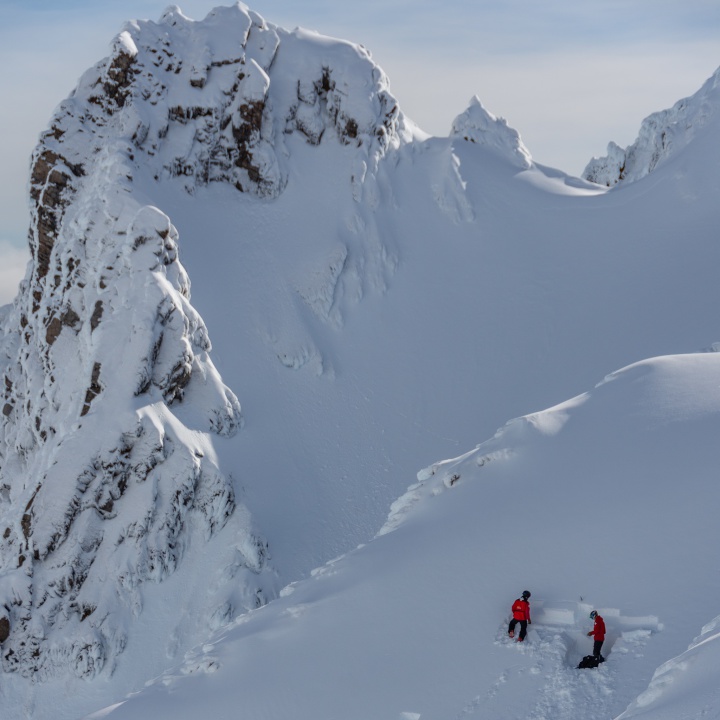The science of avalanche control
The science of avalanche control
MT RUAPEHU, 17 AUGUST 2019: The science of avalanche control on Mt Ruapehu is a complex one.
Every day routine avalanche control procedures are conducted before Whakapapa or Tūroa ski fields are cleared to open safely to the public and staff. But this is only one aspect.
Making sure the mountain is safe is a science, with skills acquired over years and years of working in the mountains. The variability of weather patterns on Mt Ruapehu leaves behind a complex buildup of snow deposits and layers.

The likes of Ryan Leong (Snow
Safety Officer for Whakapapa Ski Area) and Dave Kelly (Snow
Safety Officer for Tūroa) spend their winters studying
these messages stored in the layers. Looking for clues on
which of these layers to be aware of in anticipation of the
next storm.
Mt Ruapehu GM Safety and Environment Andy Hoyle says, “Storms bring precipitation in the form of snow, hail, sleet and wind. Each storm leaves its mark in the stratigraphy of the snowpack. Layers build upon layers, a kind of temporary record of time. Oldest at the bottom, youngest on top. Occasionally, some layers are weaker than others and can fail when the load of the layers above gets too heavy. Once things start to move, this is known as an avalanche.
“Snow layers don’t build up in a uniform manner either, further adding to the complexity of studying and predicting snowpack movement. With Mt Ruapehu sticking up in the middle of the central North Island Plateau it gets hit from weather fronts of all kinds and directions. This causes certain aspects to accumulate more snow than others, in different densities and depths.”
The team at Mt Ruapehu is constantly working on making the ski fields safe, as shown by the recent avalanches at Tūroa. These avalanches were set off during avalanche control, in areas identified by the snow safety team as areas of weakness.
“As shown by the destructive force of these avalanches, it’s important visitors to the mountain respect any closures put in place,” Andy says.
“When on the mountain, make sure you are aware of any avalanche control work underway but also other warnings put in place surrounding safety on the mountain. Be sure to follow the Mt Ruapehu uphill access guidelines, check them out on our website www.mtruapehu.com/mountain-safety. If you are heading out of the ski area boundary, it is important that you visit www.avalanche.net.nz and ensure you are comfortable with the conditions present on the day.”
Andy says that the team is often asked,
‘what if you just left it’? “We know that if we left
these avalanche hazards uncontrolled, they could occur
naturally in the right conditions, threatening personnel and
infrastructure. For evidence of this, check out www.avalanche.net.nz.where you can see
great photos of other natural avalanche cycles in Tongariro
National Park from the last few days,” he says.
“So, as part of our process of looking after our people, customers and resources, we are duty and morally bound to actively manage these hazards as soon as we practicably can.”
All of this makes studying the snow an important, non-stop job. Both rewarding and challenging, it sees Mt Ruapehu’s safety and patrol teams out in the best and the worst conditions to keep everyone safe.
mtruapehu.com


 Gordon Campbell: On The Hikoi Aftermath
Gordon Campbell: On The Hikoi Aftermath NZ Government: PM Marks One Year In Government
NZ Government: PM Marks One Year In Government Helen Clark Foundation: Helen Clark Foundation Calls For Political Action To Reduce The Prevalence Of Junk Food And Improve Health Outcomes
Helen Clark Foundation: Helen Clark Foundation Calls For Political Action To Reduce The Prevalence Of Junk Food And Improve Health Outcomes Justice Committee: Further Decisions About Submissions Process For The Principles Of The Treaty Of Waitangi Bill
Justice Committee: Further Decisions About Submissions Process For The Principles Of The Treaty Of Waitangi Bill Infrastructure New Zealand: Single Agency Needed To Coordinate Climate Adaptation And Recovery
Infrastructure New Zealand: Single Agency Needed To Coordinate Climate Adaptation And Recovery Free Speech Union: Fair Digital News Bargaining Bill Likely To Restrict Access To Information, Polling Shows Most Oppose
Free Speech Union: Fair Digital News Bargaining Bill Likely To Restrict Access To Information, Polling Shows Most Oppose Auckland Transport: Driver Safety Screens Now Rolling Out Across Auckland’s Bus Fleet
Auckland Transport: Driver Safety Screens Now Rolling Out Across Auckland’s Bus Fleet


